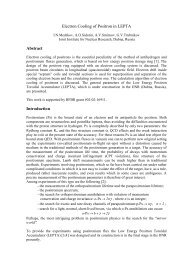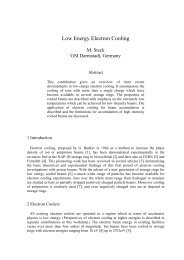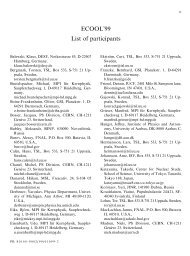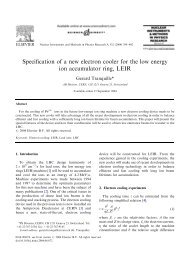Mucool Hydrogen Absorber R&D - BETACOOL home page
Mucool Hydrogen Absorber R&D - BETACOOL home page
Mucool Hydrogen Absorber R&D - BETACOOL home page
Create successful ePaper yourself
Turn your PDF publications into a flip-book with our unique Google optimized e-Paper software.
THE MUCOOL TEST AREA AT FNAL<br />
In late 2003, construction of the MTA was completed at the site of the old access<br />
tunnel to the FNAL Linac, and is now the focus of MuCool activity at FNAL. The<br />
MTA is designed to accommodate the full Linac intensity of 1.6X10 13 protons/pulse at<br />
15Hz or 2.4X10 14 protons/s, or 600W energy deposition into a 35 cm long liquid<br />
hydrogen absorber at 400 MeV. The test area will provide power from the Linac to<br />
operate 201 MHz and 805 MHz RF test cavities. A first LH2 test has been completed<br />
with the KEK convection absorber, and RF testing (both 805 and 201 MHz) is<br />
planned. A cryogenic facility is scheduled for completion near the end of 2005 that<br />
will provide refrigeration power of up to 350W for the hydrogen absorber, as well as<br />
cooling for the superconducting solenoid.<br />
LH2 ABSORBERS<br />
The issues that drive the absorber design and tests are: 1) the large amount of heat<br />
that needs to be extracted from high intensity beams; 2) the desire to minimize<br />
multiple scattering; and 3) the densely-packed and high radiation environment in<br />
which absorbers will be operating in a real cooling channel. Additionally, the<br />
combustive nature of hydrogen requires special safety considerations that drive much<br />
of the engineering and design.<br />
Minimizing the multiple scattering has lead to novel window designs that depart<br />
from the standard shell profiles [3]. For efficient heat removal, two different absorber<br />
designs have been proposed: 1) an internal heat exchange design, where the LH2<br />
mixing is achieved by natural convection cells, driven by the beam-deposited heat and<br />
the cold walls of the heat exchanger (with cold He gas) and 2) an external heat<br />
exchange design where the heat exchanger is in an external loop of hydrogen and the<br />
LH2 mixing is achieved with an external pump with nozzles oriented at various angles<br />
to establish turbulent flow. These are shown in Figure 4.<br />
Thin Window Designs and Test<br />
Designs for thin windows have matured, where windows of equivalent strength to<br />
standard designs have been realized with less than 30% their minimum thickness.<br />
Figure 3 shows the evolution of the window profiles. The current design has a profile<br />
with an inflected curvature where the thinnest section (around the center) is<br />
membrane-stress dominant: under the ultimate pressure (rupture) the greatest stress is<br />
experienced at the center.<br />
444








